My best friend and I were originally planning a trip to Mexico for May 2020 where we were going to spend 10 days split between Mexico City and Oaxaca City. We heard four full days were enough to get a taste of Mexico City, so we thought that would be the best use of our time.
For obvious reasons, we had to postpone our trip to 2022. By this time, our trip was only eight days, including travel. We had to decide if we were still going to try to split our time between the two cities. After looking into what we wanted to do in Mexico City a bit more, we decided to spend the full time in one city. We’re really glad we did! Even a week was not long enough to fit in everything we wanted, but we still saw a lot.
Here is the one-week itinerary of my time in Mexico City:
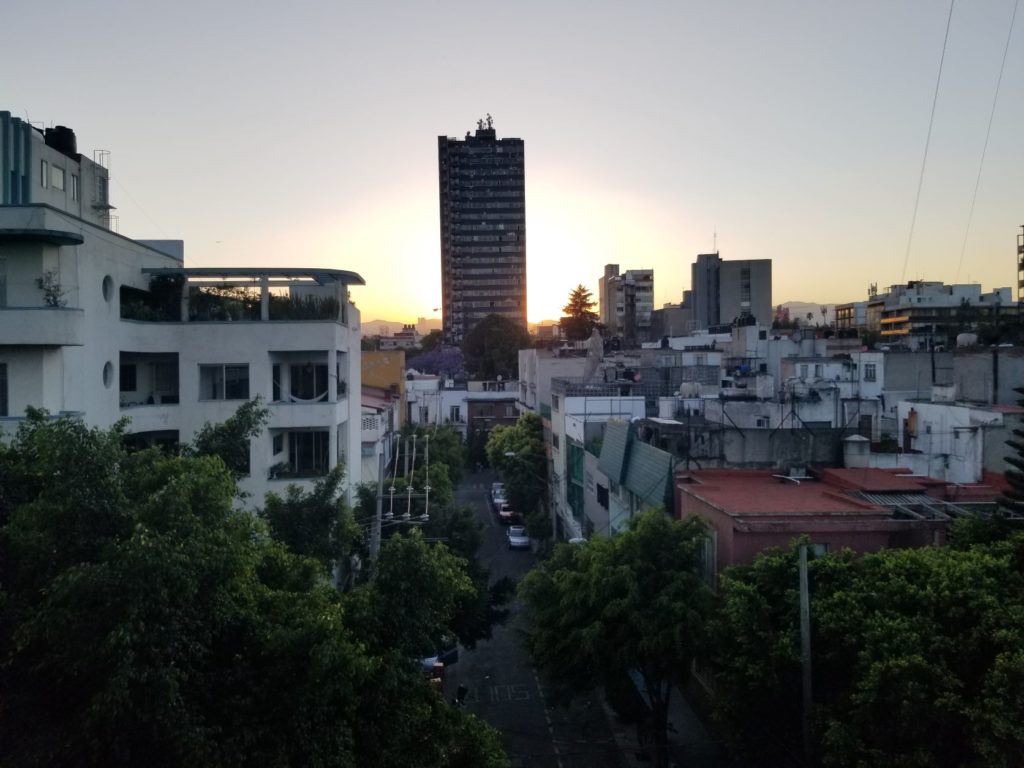
Day 1: Arrival & Uruguayan Food
I arrived in Mexico City late afternoon on the first day and met my friend at the airport. It was important to us to get to the city in the daylight to get a first glimpse of it. I called an Uber, and we headed to the Polanco neighborhood.
We were glad we prioritized getting into the city in the daylight. It was invigorating to watch a new city pass by our windows and get an introduction to life in CDMX.
CDMX is a huge city. By the time we got to Polanco and checked into our hotel, the sun was setting. We decided our primary activity for the day would be to find a good dinner place. We did some Googling and settled on a Uruguayan restaurant with good Google reviews. Neither of us had had Uruguayan food before, and it seemed like a good introduction to Latin America.
We took an Uber to Pipí Cucú Bistro where our Spanish lessons from Duolingo were immediately put to the test. We…were not prepared. Luckily, our waiter was very understanding and patient with us. He kept us from ordering way too many tacos, and was very kind and friendly in general. After some delicious empanadas, tacos and beer, we headed back to our hotel excited to truly begin our Mexico City adventure.
Day 2: Polanco Neighborhood, Mercado de la Merced & Margaritas
Our first full day in Mexico City began by exploring more of the Polanco neighborhood. Polanco is one of the wealthiest neighborhoods in CDMX. We were only staying there for two nights due to a hotel credit I had to use.
We strolled through the nearby Parque Lincoln to pick up some coffee and breakfast and sit in the park. Watching people go about their day with their immaculately styled clothes, hair and dogs, it was easy to tell this was the wealthy part of the city.
After watching the world pass by for a bit, we walked to a quirky bookstore nearby called El Pendulo. Mexico City is somewhat known for having interesting bookstores, and El Pendulo is one of them. It is a multi-story bookstore that has a giant atrium and decor meant to evoke a sense of peace and tranquility. It was mostly empty when we visited, which made it feel even more peaceful.
After walking a couple more loops through the neighborhood, we decided to check off one of the biggest sites on our list: Mercado de la Merced.
Mercado de la Merced is a traditional open-air market. It is one of Mexico City’s oldest commercial centers, and has been an important center of trade since the 1800s. The market is beautiful organized chaos. It seemed like you could get just about anything there. Food, spices, candy, shoes, clothes, toys – whatever you want! A former coworker recommended it to me, but I didn’t know much about it until we were heading there in the Uber. Then I decided to actually look up exactly what we were doing.
Inside Mercado de la Merced
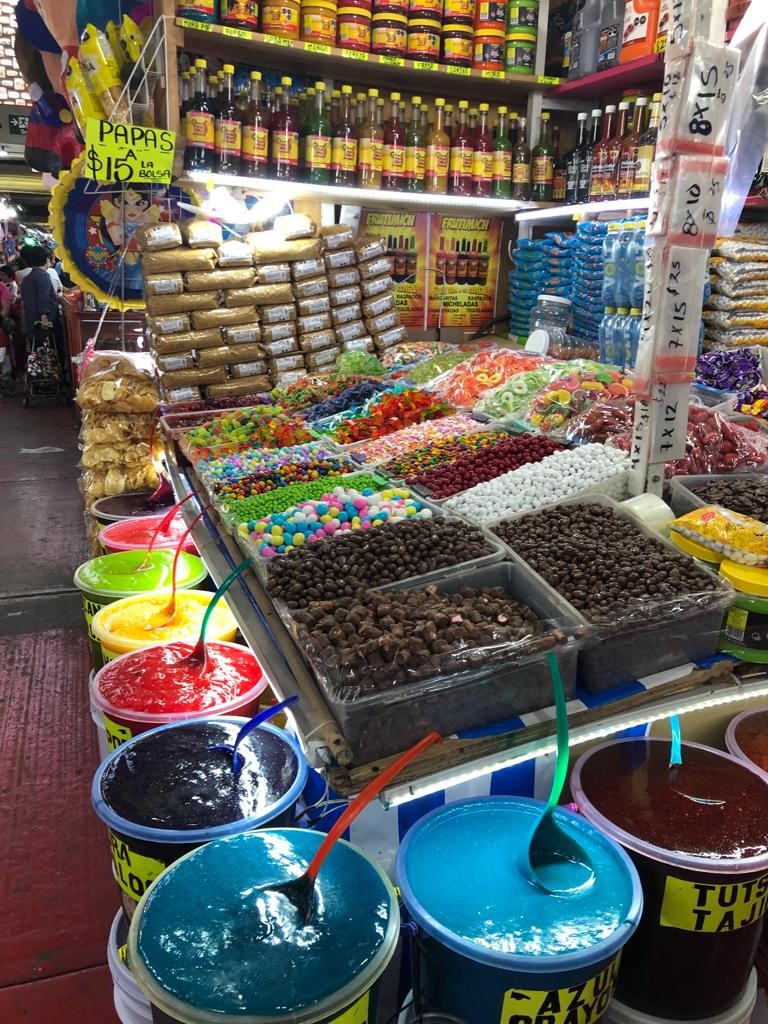
I knew La Merced was considered one of the more dangerous neighborhoods in Mexico City. I assumed inside the market would be fine (spoiler: it was). However, as I scrolled through Trip Advisor reviews warning gringos against visiting by themselves and watched the city change outside the window of the Uber, I got nervous. The Uber dropped us off across the street from the market, and the presence of stacks of shelves of dirty magazines and prostitutes working in broad daylight felt a little sketchy. We hurried across the street into the market, and everything was fine.
We got lost in the chaos of the market, going down random aisles towards whatever looked interesting and eating at any food stall that looked good. This method helped us find delicious bean and potato tacos where we got five small tacos for only $0.50 USD! Still, we were cautious, avoiding flashing our phones or cash and speaking English as little as possible.
After a couple of hours, we got our fill of the market. It turned out the market was at the edge of a metro station, which seemed like an easier and safer way to get in and out of it.
(Note: If you want a more organized trip to the market, a lot of companies like Viator and Airbnb Experiences offer tours.)
The metro line we were on didn’t go to Polanco. Instead, we got off at a stop near the Roma neighborhood in search of margaritas. After a couple of margaritas and a detour to try chapulines (grasshoppers), we went back to our hotel.
Day 3: La Condesa Self-Guided Walking Tour & Parque Mexico
After two days in our fancy hotel, we switched neighborhoods and accommodations. We packed up our backpacks and headed to an Airbnb in the neighborhood of La Condesa. This area of town was a bit more our speed, with lively music playing and street food stalls on every corner. Our Airbnb was also next to an amazing bakery that opened my eyes to Mexican baked goods. People may talk about the bakeries in Paris, but the bakeries in Mexico City should not be missed!
I’m typically a big fan of city walking tours as a way to get to know a city and neighborhood, but they’re a bit slow-paced for my friend. We compromised with a self-guided Condesa walking tour we found online. We spent most of the day following this walking tour and discovering amazing spots in the neighborhood. Some highlights included a small mom-and-pop bakery with delicious sweet bread called Garcia Madera, a beautiful pedestrian walkway called Avenida Mazatlan, and rooftop bar atop a hotel where we got aperol spritz.
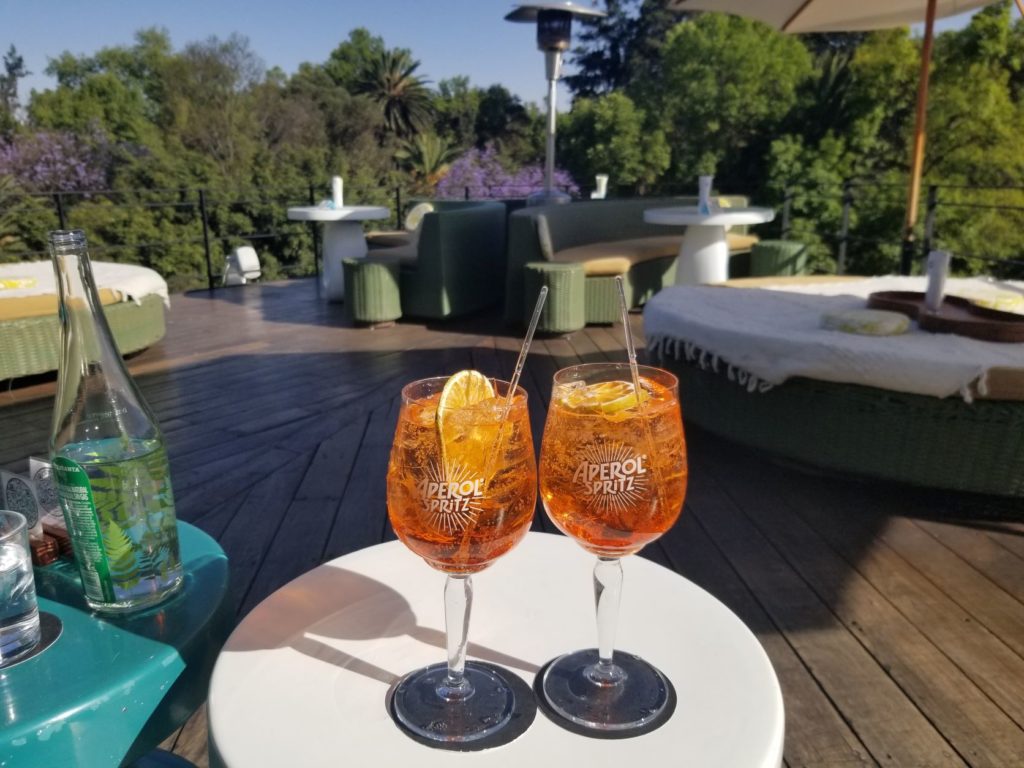
We ended the tour at one of the last recommended stops of Parque Mexico. Parque Mexico is a huge green space in La Condesa where there seems to be something for everyone. We spent some time there just watching people skateboard, dance and make art. There were also plenty of street vendors selling snacks and beverages around the park, as well as restaurants and bars.
We ended up getting tacos on the way back to our Airbnb.
Day 4: Xochimilco, Museo Nacional de Antropología, Chapultepec Park & Oaxacan Food
The next day we headed to another site that Trip Advisor tried to scare us away from visiting. The neighborhood of Xochimilco has a canal network flowing through it where Aztec farmers built floating gardens in pre-colonial times. In the present day, you can board a colorful flat-bottomed boat called a trajinera and float past these gardens.
Trip Advisor warns about tourist scams where the employees at the embarcaderos try to overcharge tourists for rides on the trajineras. However, if you know the right price (~500 pesos per hour) and go to the right Embarcadero, you should be fine. Embarcadero Nuevos Nativtas openly displays their prices, which decreases the chances of getting scammed.
Xochimilco was pretty far from the center of the city, so we took an Uber there and enjoyed observing new areas of CDMX. Men started approaching us to buy a boat ride as soon as we got out of the Uber. We wanted to walk around and look at the vendors for a bit before boarding a trajinera, so we just told them not yet. They weren’t too aggressive. When we were finally ready to take our boat ride, we easily found someone.
Trajinera Ride
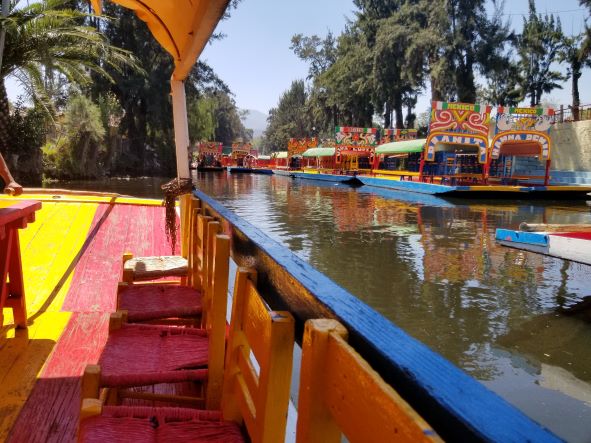
The boat seemed comically large with just two people – most other boats had larger groups. However, we settled in and had a pretty relaxing time on the water. Vendors floated by in smaller boats trying to sell everything from food and drinks to jewelry to mariachi performances. Once in a while, a vendor would also board our boat to try to get us to buy something, but we just had to say no thanks. During our float, we bought beers and snacks and enjoyed watching the scenery. It was also interesting to observe residents of the neighborhood going to and from their houses via canal. We didn’t even have to buy a mariachi performance because we could watch them performing on the other boats around us!
One note, if you do want to buy something, make sure to ask the price in Spanish. One vendor tried to get us to buy something and originally told us the price in Spanish. Then, she repeated herself in English and doubled the offered price. Despite my mediocre Spanish, I still understood that.
Museo Nacional de Antropología
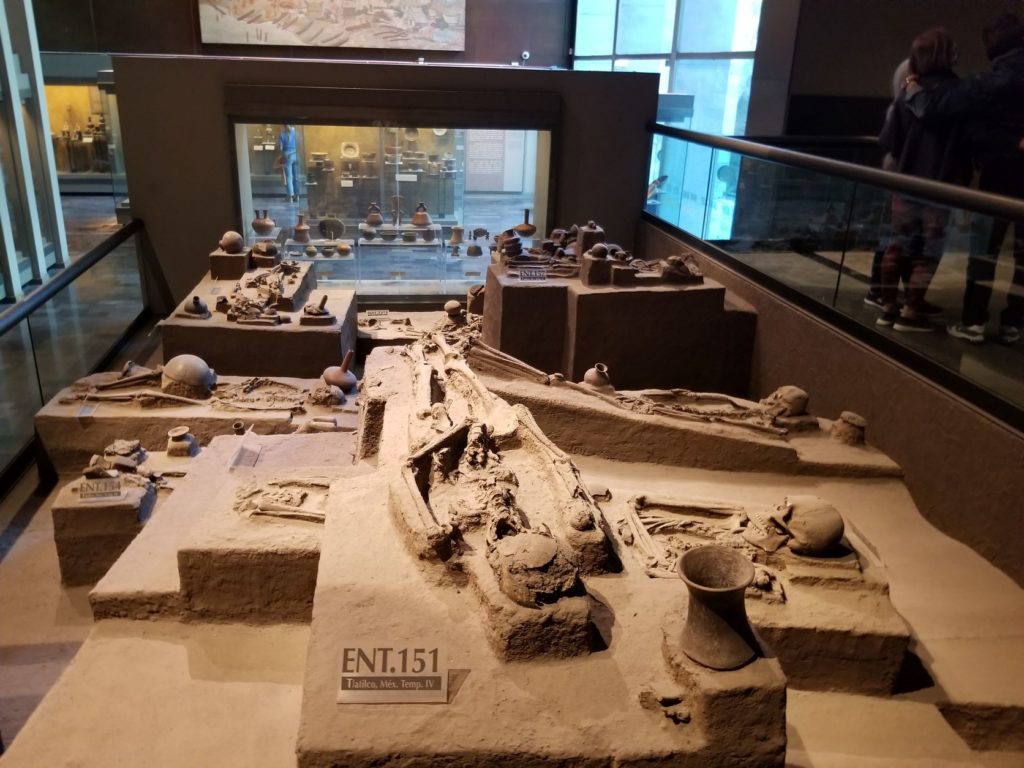
After our boat ride, we took an Uber to another highly-recommended attraction: Museo Nacional de Antropología (National Museum of Anthropology). Mexico City has one of the highest concentrations of museums in the world, and the Anthropology Museum is considered one of its best. It has the world’s largest collection of Mexican art and many ethnographic exhibits on Mexico’s indigenous groups.
We got there about two hours before closing, which was definitely not long enough to see everything. I started going through the first few exhibits at a pretty leisurely pace, then soon realized I needed to speed things up. Even at a faster clip, I needed at least another hour.
Before we knew it, we had to leave. We moseyed over to Chapultepec Park, which borders the main museum cluster in the city. This park is huge and arguably the most popular park in the city. It has a zoo, vendors and a large lake where you can rent boats. It also borders La Condesa, so we walked through the park to get back to our Airbnb.
For dinner that night, we tried a nearby Oaxacan restaurant so I could get proper mole and mezcal.
Day 5: Centro Historico, La Romita Vintage Shops & Tacos
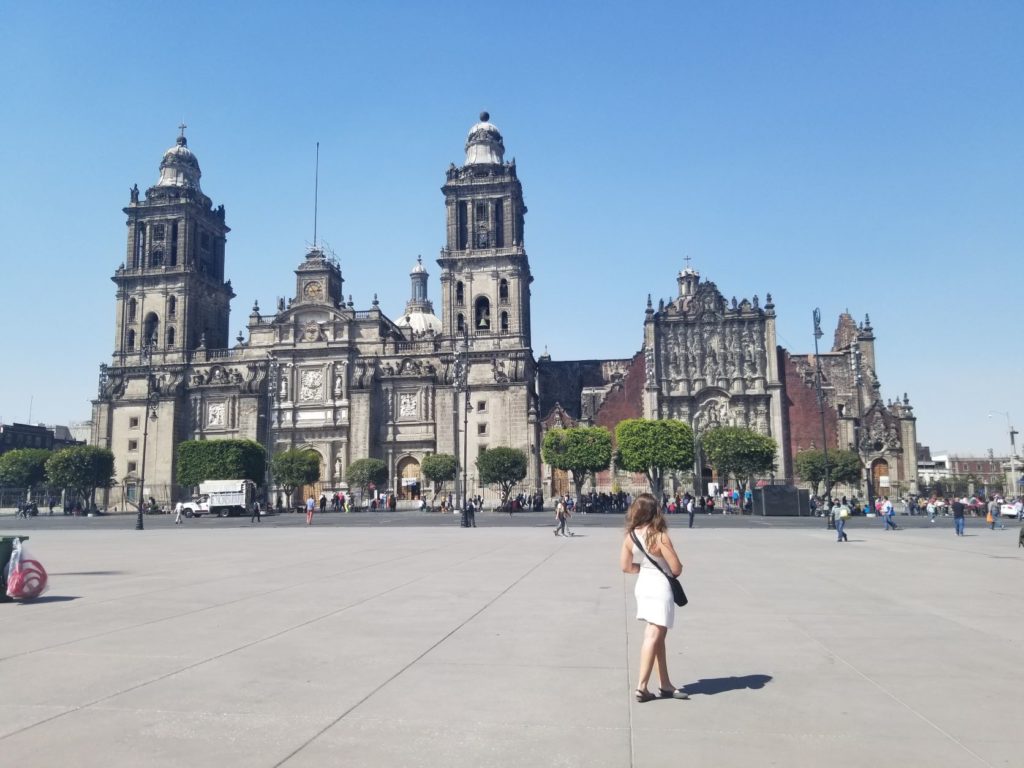
The next day, we decided to explore the Centro Historico (the Historical Center). We took the metro to the main square of Centro Historio, known as the Zócalo. The Zócalo was the main ceremonial center of the city for the Aztecs, and it is still a place for public gatherings. We took our time wandering through the historical center. Some highlights were seeing the Palacio Nacional and the Palacio Postal, the most ornate post office I’ve ever seen. When I visited the main area of Lima’s historical center, it reminded me of a lot of this part of Mexico City. Our tour guide in Lima said it made sense as they were both major capitals of Latin America during Spain’s rule.
Centro Historico is obviously very touristy, but also a must-see. Supposedly, it gets a little sketchy at night but is fine during the day time.
After getting our fill of the historical center, we took the metro to the La Romita neighborhood, on the edge of Doctores. Here, we had the best tacos of the trip. Doctores is known to be a bit of a sketchy neighborhood. Tourists are generally advised not to go there unless for a Lucha Libre show at Arena Mexico. We felt safe enough in the middle of the day on the edge of the neighborhood, but it is good to be cautious.
After lunch, we browsed some vintage shops in La Romita. We didn’t end up buying anything, but it was fun to browse.
Day 6: Teotihuacan, Monumento a la Independencia & Zona Rosa
The next day was an early start because we were finally going to see the pyramids of Teotihuacan. We booked a hot air balloon ride over the pyramids at sunrise via Viator. The trip included an early morning van pickup in town and coffee and snacks before heading to the balloons.
After a magical sunrise balloon ride, we had a breakfast of chilaquiles with a mariachi band performance. Then, it was time to go to the pyramids. Before exploring the archaeological site, we got a lesson in Aztec history that included examples of obsidian stones and tequila tastings.
We had an option of a guided tour with the same company, but chose to explore the pyramids at our own pace. After a couple of hours, we rejoined the van to return to Mexico City.
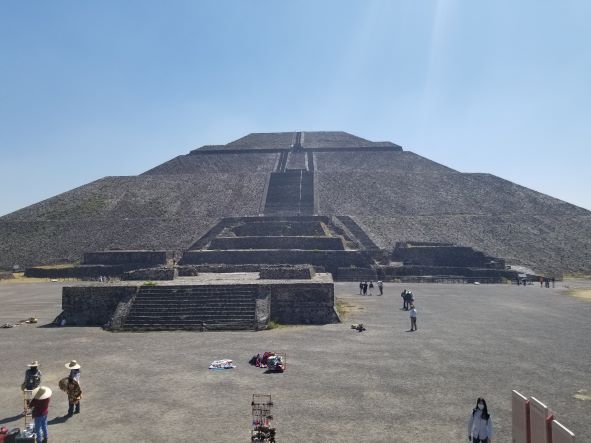
Once we got back to our Airbnb, we briefly considered the idea of a nap then discarded the idea. Instead, we ventured out to see Monumento a la Independencia, also known as El Ángel. It is a monument to independence first erected in the early 1900s and stands prominently in the middle of a busy intersection in La Reforma. We walked to El Ángel from our Airbnb and picked up tortas on the way for an early dinner, which we ate on the steps of the monument.
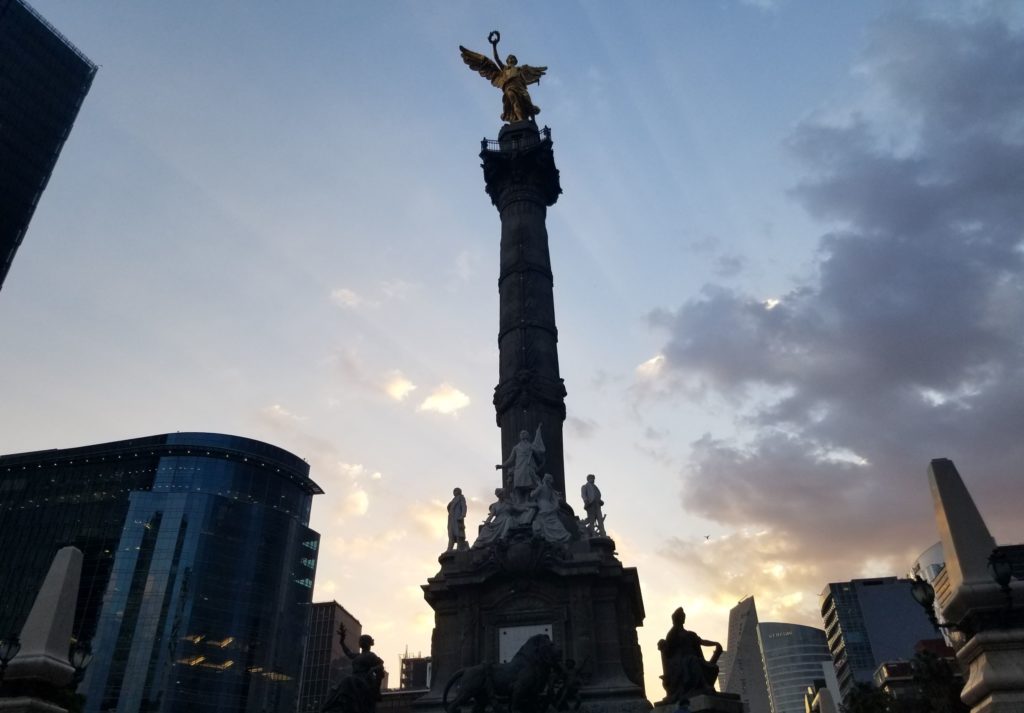
From there, we decided to explore another neighborhood called Zona Rosa, which is the queer district. We visited a couple of bars here before going home.
Day 7: Museo Tamayo, Skulls & Art Museum & Lucha Libre
The next day was our final full day in Mexico City before heading home. We started the day with one of the stops on the self-guided Condesa walking tour we didn’t get to originally. La Esquina del Chilaquiles is a popular place to get breakfast in the neighborhood, serving delicious chilaquile-stuffed tortas. There is a somewhat long line, but they are worth it.
After breakfast, we decided to check out two museums we wanted to see. Museo Tamayo is a modern art museum in Mexico City. We spent a couple of hours walking through and attempting to interpret the pieces that most caught our eye.
Then, we went to the Instagram-worthy Skulls & Art Museum. This museum had five immersive exhibits that showed skulls of varying colors and textures. Each area offered a totally unique experience and was quirky and fun.
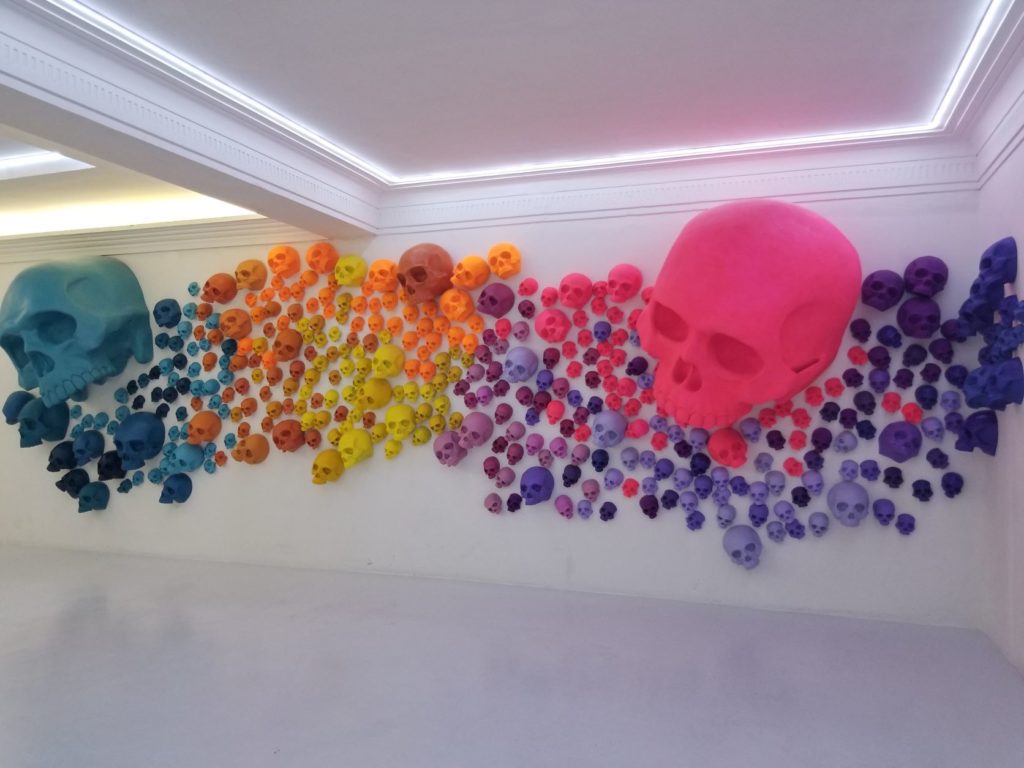
Finally, it was time to do something I’d been looking forward to since we’d originally started planning the trip two years prior: Attend a Lucha Libre show. Lucha Libre is a Mexican wrestling show where wrestlers/performers dress up in costumes and masks and put on an incredibly entertaining show. There are two places in the city to watch Lucha Libre, but the most common place is the larger Arena Mexico that hosts shows every Tuesday, Friday and Sunday.
We took an Uber to the arena and soaked in the chaos outside as we tried to find a place to buy tickets. I’d read online that the tickets were cheaper at the arena, but they didn’t seem to be any different than the prices I’d seen for tickets online, so I don’t think it matters.
After some trial and error, we found our section and a couple of beers, then settled into our seats to enjoy the show.
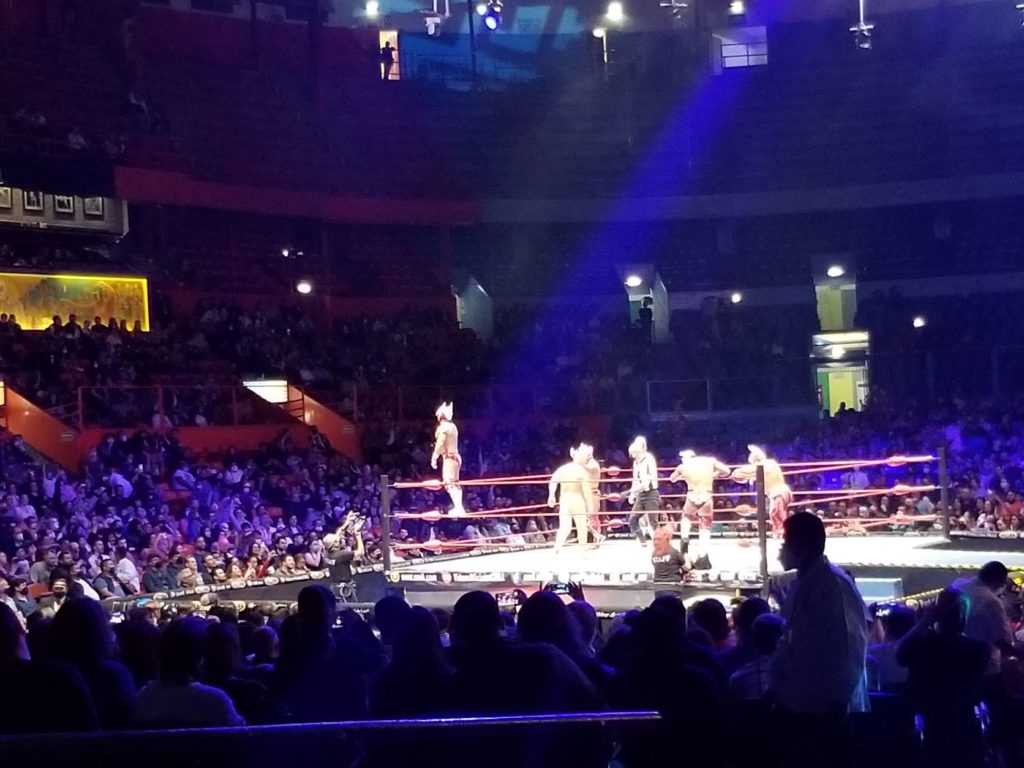
Day 8: Tacubaya Subway Murals, Churros & Departure
It was our final day in Mexico City, and we had a couple more things to do before leaving. One was the Tacubaya subway station murals. Guillermo Ceniceros painted these murals in 1987, and they have stuck around through the present day. They represent pre-Hispanic Mexico and depict the Aztec city of Tenochtitlan in one area and Aztec mythology in another section.
We took the metro to the station then walked around seemingly in circles until we finally located the giant murals.
Then, we headed back to La Condesa to spend our last couple of hours in Parque Mexico and try a final food. A friend told me about a 100-year-old churro place at the edge of the park called Churrería El Moro, and I didn’t want to miss it. The churros came with a choice of caramel or chocolate sauce and were absolutely perfect.
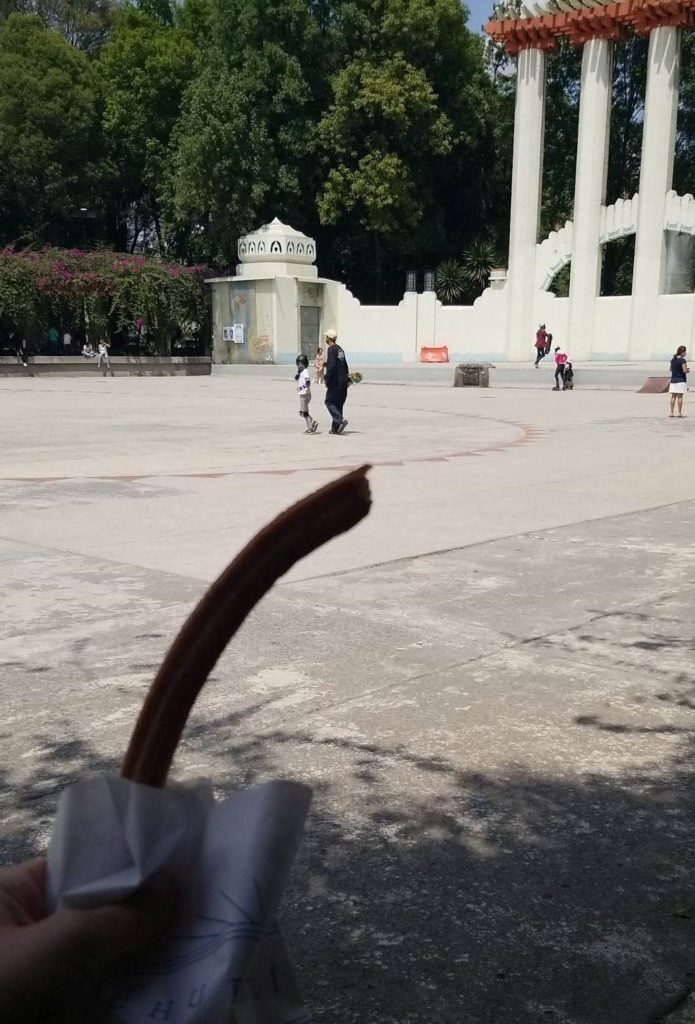
Finally, we said our goodbyes to Mexico City and to one another and headed home. I was grateful for all the things we got to do in the city, but there are definitely others that we couldn’t quite fit into the week. For example:
- Museo Frida Kahlo
- Exploring the Coyoacán neighborhood
- Hiking
- Hot springs
Though we spent a week in Mexico City, we left feeling like we’d just scratched the surface!
Some Logistics:
Where to stay:
There are a few popular neighborhoods to stay in Mexico City:
- Polanco: This neighborhood is one of the wealthiest areas of CDMX. It has some of the top hotels and restaurants and is generally considered very safe.
- La Condesa, La Roma & Zona Rosa: These neighborhoods are next to each other and are popular tourist areas. They are close to cool restaurants, bars and other attractions and are safe and walkable.
- Centro Historico: This neighborhood is the best place to stay if you want easy access to the historic center. However, it is only considered safe during the day, so you might not feel okay walking around at night.
Transportation:
We used two types of transportation to get to different parts of the city:
- Uber: I have T-Mobile, so I had data throughout CDMX and was able to call Ubers at any time. Ubers were cheap and easy to call, and they gave us protection that hailing a taxi on the street wouldn’t have had. To be 100% safe, we only called Ubers from inside establishments (never just standing and waiting on a dark street corner).
- Metro: The metro in CDMX is cheap and fast and felt completely safe. We only took the metro through safe neighborhoods and never had a bad experience.
Safety:
Mexico City has a reputation for being dangerous, but we honestly felt okay the entire time. We stayed in safe neighborhoods and were not flashy with money or other expensive items and did not feel unsafe.
Have you been to Mexico City? What did you do? What else did we miss?
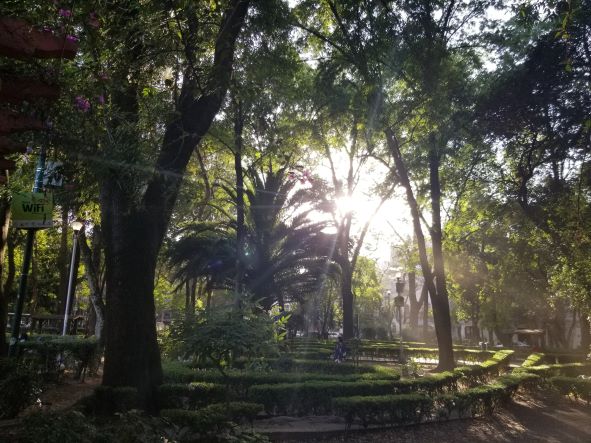

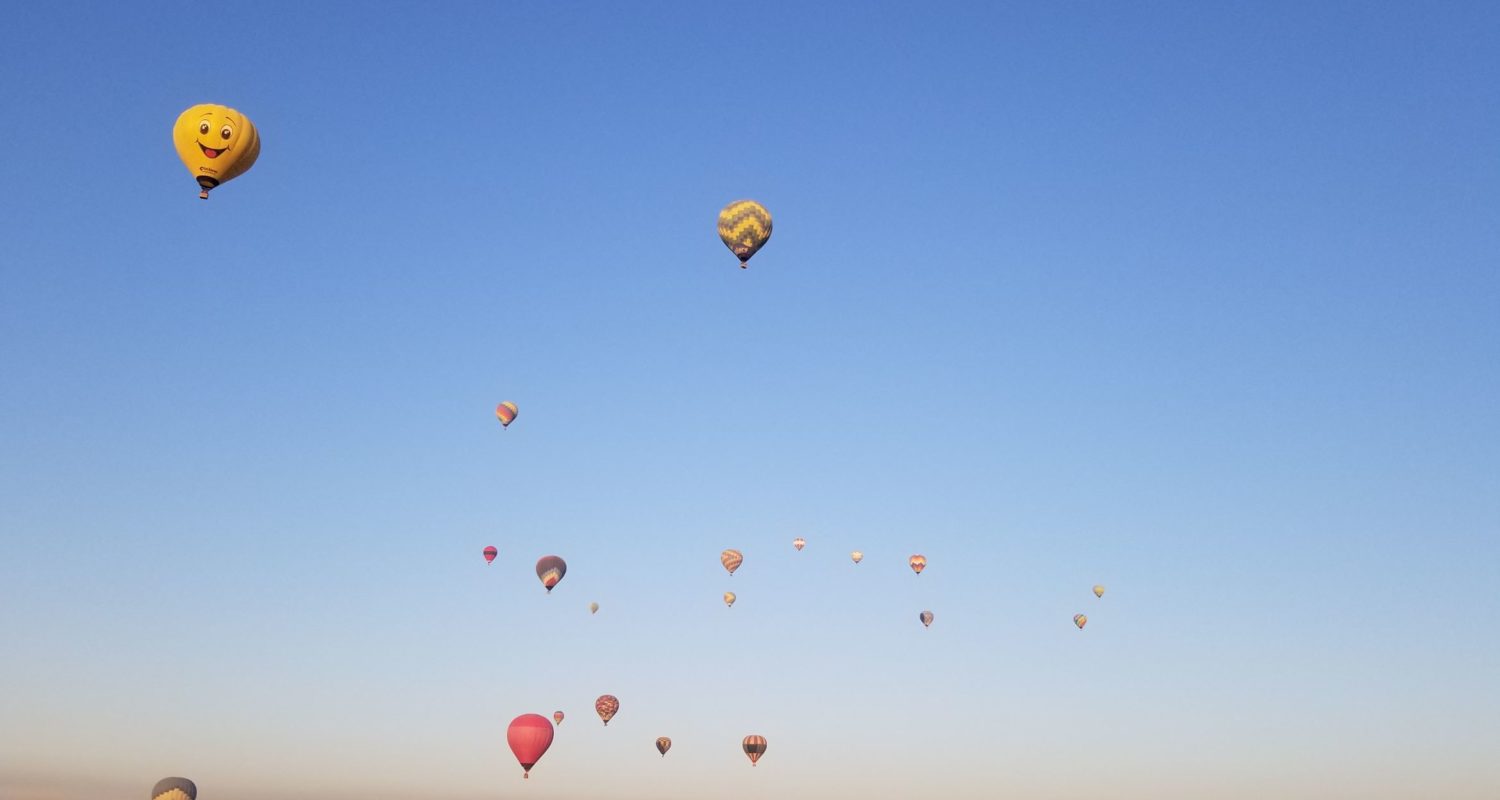
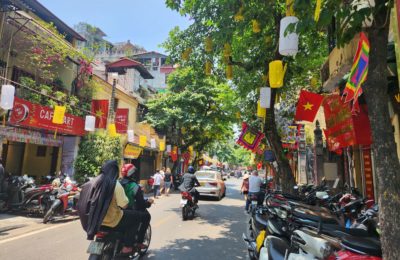
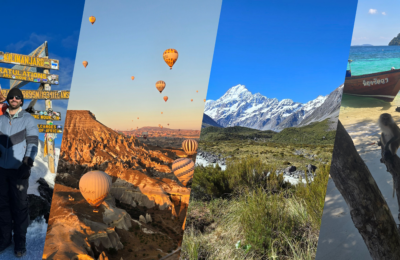
One thought on “Mexico City: How to Spend an Amazing Week in Mexico’s Capital”